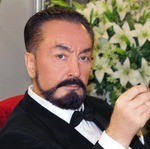8. The Flowless System That Regulates Blood Pressure
The moment blood pressure falls, a flawless system in your body goes into action. In the same way that smoke detectors are specially designed to recognize the particles emitted by fire, this "alarm" system goes into operation only when there is a drop in blood pressure.
Low blood pressure may give rise to a very dangerous state of affairs. Therefore, the moment such a drop is detected, a series of measures need to be taken in order to raise it back up again. These measures can be detailed as follows:
1. Blood vessels must be constricted. (This, in turn, will raise blood pressure, in rather the same way that water emerges under higher pressure when a garden house is squeezed.)
2. More water must be absorbed from the kidneys and released into the bloodstream.
3. The individual must be made to drink water as quickly as possible.
But how does all this happen? Yet another matchless system has been located in the depths of the human body.
The moment that blood pressure (or the level of sodium in the bloodstream) falls, certain cells in the kidneys take notice. These cells that sound the alarm are the juxtaglomerular (JGA) cells, which secrete a special substance called rennin7(Figure 40)
The way that cells are able to determine that blood pressure or sodium levels have fallen is a miracle in itself. More important, however, is the cells' secretion of rennin, because that is the first stage in a long chain of production.
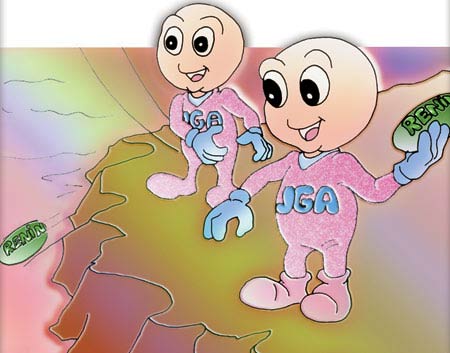 |
| Figure 40: The moment that blood pressure falls (or when the level of sodium in the blood decreases), cells in the kidneys known as juxtaglomerular cells (JGA) enter a state of alarm and secrete a special substance known as rennin. |
 |
| a. Rennin |
| Figure 41: Just like the components of a jigsaw puzzle, angiotensinogen and rennin have been created to be able to wrap around one another. Figure 42: Rennin changes the structure of the angiotensinogen molecule, and a brand-new molecule emerges—angiotensin I |
In blood plasma, there is a protein that normally has no effect as it circulates around in the bloodstream. This is angiotensinogen, which is produced in the liver. Here begins the first stage of an utterly amazing plan. That is because angiotensinogen and rennin—which serve no purpose on their own and by themselves—have been specially designed to combine with one another, in the same way that the components of a machine are often designed so as to be able to be linked to one another (Figure 41).
Another point here calls for reflection—and astonishment. Kidney cells and liver cells are far distant from one another in the body. How is it that in producing one element of a compound (rennin), another organ will produce the other element of the compound (angiotensinogen) to fit it—and how is it the two will be mutually complementary? It is definitely impossible for this to happen by chance, as evolutionists would have us believe. No doubt that each has been created under the inspiration of Almighty God.
Rennin alters the structure of the angiotensinogen molecule, as a result of which an entirely new molecule emerges—angiotensin-I (Figure 42).
Rennin + Angiotensinogen = Angiotensin-I
But this newly emerging molecule has no effect, because the chain of production is not yet complete. An enzyme by the name of ACE, found in the lungs and serving solely to break down the angiotensin-I molecule, now enters the equation. Thanks to this enzyme, angiotensin-I turns into yet a different molecule, angiotensin-II (Figure 43).
Angiotensin-I + the ACE enzyme = Angiotensin-II
Once again, we need to step back and reflect. Two different molecules produced by the kidney and liver cells have combined with each other, and a new molecule has emerged. Lung cells, which are totally unconnected to the kidney and liver cells, produce another enzyme that will perfectly attach to this new molecule. In addition, they produce this enzyme long before the molecules in question have combined together. But how do lung cells produce the most appropriate enzyme for an event that has not yet taken place—to bind with a substance that has not yet been manufactured? How do they know the formula for an enzyme that will convert one molecule into another? No doubt is the incomparable God Who inspires this knowledge in the lung cells.
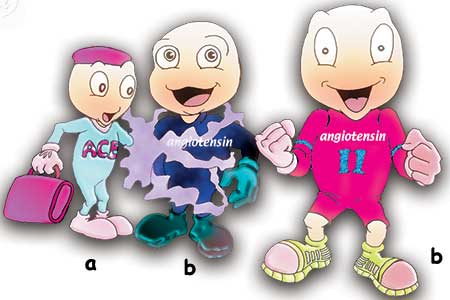 |
| a. ACE |
| Figure 43: The enzyme ACE turns angiotensin I into yet a different molecule, angiotensin II. |
The enzyme angiotensin-II has two vital functions; first, to ensure the constriction of the blood vessels. Angiotensin-II stimulates the muscles around the blood vessels and sets the mechanism that provides the contraction—yet another proof of flawless creation. The muscles are thus contracted, the diameter of the blood vessels is reduced and blood pressure is elevated. This is the first intended outcome.
The second major duty of angiotensin-II is to call to duty the miraculous hormone aldosterone. When the angiotensin-II reaches the adrenal cells, it commands them to secrete aldosterone. This is yet further proof of the flawless nature of the allover blueprint, because the aldosterone will affect the kidneys, causing them to re-absorb the water in urine and release that water back into the bloodstream. In this way, the volume of blood will rise, together with blood pressure, which is the second desired outcome (Figure 44).
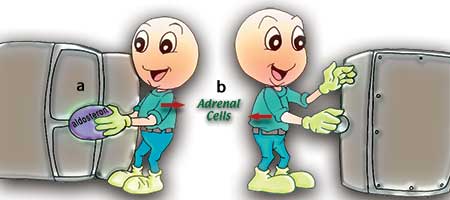 |
| a. Aldosterone |
| Figure 44: Angiotensin II reaches the adrenal cells above the kidneys and commands them to secrete aldosterone. This affects the kidneys, causing them to re-absorb water from the urine and release it back into the bloodstream. This results in an increase in blood pressure. This magnificent plan functions absolutely flawlessly and is a manifestation of the omniscience of God. |
Angiotensin-II, produced as a result of communal labor among the kidney, liver and lungs, has another very important function: to stimulate into action a special region of the brain known as the thirst region.
However, there is a major obstacle facing angiotensin-II. That is because in order to protect the brain, a very selective system that makes passage from the blood to the brain tissue difficult, known as the blood-brain barrier. But there are one or two points in the brain in which this system is not present, one being the thirst center. Thanks to this special creation, the thirst center is stimulated and the individual develops an urge to drink 8 (Figure 45).
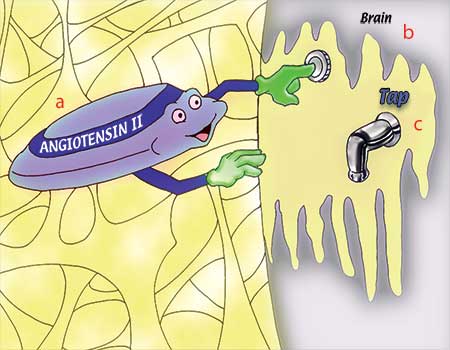 |
| a. Angiotensin II |
| Figure 45: Angiotensin II stimulates the thirst region in the brain, and a person thus feels the urge to drink. |
The substances produced by the kidneys, lung and liver—jointly, and in accord with a rearranged blueprint—are combined in a regular manner, as a result of which they ensure the secretion of a hormone that causes blood pressure to rise. To achieve this, the cells of the kidneys, lungs and liver have to join forces and establish a coalition.
When blood pressure falls, this consortium of organs must investigate what needs to be done. Then, as a result of this investigation, the coalition has to decide on the ideal solution: which is narrowing the diameter of the blood vessels and also ensuring the secretion of the hormone aldosterone.
Then, these organs again must cooperate to carry out lengthy research and analyze the anatomies and working systems of the adrenal glands and muscle cells around the blood vessels. They then must determine a molecular project to contract these vessels and for the miraculous formula of angiotensin-II to stimulate the adrenal glands to secrete aldosterone.
The last job that needs to be done is determining how this final molecule is to be produced. During the production stage, each organ must assume a responsibility. Duties must be shared out in a three-stage assembly plan within the framework of the production plan already drawn up in advance. The renal cells must decide to produce rennin, the liver cells to produce angiotensinogen, and the lung cells to produce ACE; and the task of distribution must be completed. Finally, the process must be brought to an end and the cells must return to their original locations (Figures 46 and 47).
Every part of this system is full of marvels calling for further consideration. Every cell in the human body has been created for a particular task, equipped with special attributes and specially positioned exactly where it needs to best carry out its task. Our Lord has created all the events that take place in the human body, and every detail in that body is just one of the proofs of His infinite knowledge.
As Almighty God has revealed in the Qur'an:
Any mercy God opens up to people, no one can withhold, and any He withholds, no one can afterwards release. He is the Almighty, the All-Wise. (Surah Fatir, 2)
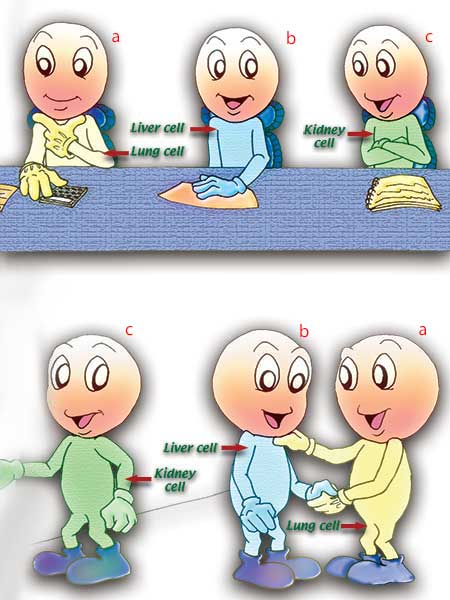 |
| a. Lung cell |
| Figure 46: Unknown to the individual concerned, the liver, kidney and lung cells literally hold a conference and distribute tasks among the cells. Figure 47: In the wake of that meeting, all the cells' duties have been set out, and each one knows what it has to do. By means of God's inspiration, these entities, all of them too small to be seen with the naked eye, keep blood pressure under control at all times. |
- Introduction
- 1. Monitors That Control the Level of Fluids in the Blood
- 2. The Body's Impeccable Security System
- 3. Mother's Milk and the Hormone Oxytosin
- 4. Calcium Measurers
- 5. The Sugar Factory
- 6. Emergency Assistance The Hormone Adrenaline
- 7. The Lysosomal Enzymes That Purify the Body
- 8. The Flowless System That Regulates Blood Pressure
- 9. Growth Hormone
- 10. The Clock in Our Bodies That Never Goes Wrong
- 11. The Miraculous Molecule That Regulates Body Temperature
- 12. An Extraordinarily Delicate Balance
- 13. Hormones That Prepare the Way For the Baby -1
- 14. Hormones That Prepare the Way For the Baby -2
- 15. The Hormones in the Male Reproductive System
- 16. Other Properties of the Hormone Testosterone
- 17. Hemoglobin: The Miraculous Oxygen – Bearing Molecule
- 18. The Communications System in the Cell
- 19. The Messenger Hormone's Journey within the Cell
- 20. Communication Control in the Cell
- 21. Protein Traffic within the Cell
- 22. Chemical Communication in the Nerve Cell
- 23. Nitric Oxide: A Skilled Messenger
- 24. The Endothelial Cell: A Nitric Oxide Production Center
- 25. The Power Station in the Human Body
- 26. The
- 27. DNA Replication
- 28. Repair Enzymes
- 29. Protein Production
- 30. The Final Stage of Protein Production
- 31. The Cell Membrane and 100 Trillion Organized Workers
- 32. What Happens at the Moment of Hearing?
- 33. Blood Clotting
- 34. The Immune System
- 35. The Journey of Vitamin B12
- 36. The Pancreas: The Human Body's Chemist
- 37. Transporter Molecules in the Cell Membrane
- 37. Complement Proteins Responsible for Protecting the Body
- 39. Anti – Acid Formulas Producing Molecules
- 40. The Consciousness Displayed by Egg Cells
- Conclusion
